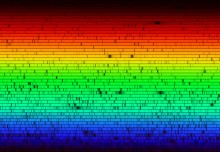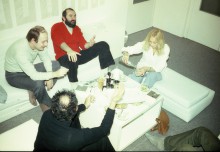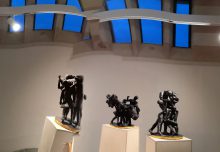“Neustále rastúce horizontálne podzemné stonky – Geopoetika v časoch antropocénu” – taký je celý názov poslednej tohtoročnej výstavy v galérii Plusmínusnula.
výstava, galéria Plusmínusnula
vernisáž v piatok 15. 12. 2017 o 18.00
výstava potrvá do ± 31. 1. 2018
vstup voľný, galéria je otvorená v pracovné dni 12.00-17.00
Antropocén je novou geologickou epochou našej planéty. Ako napovedá jeho starogrécky koreň antropos (άνθρωπος), ide o dobu ľudí. Tí sa totiž dnes ocitajú v pozícii hlavných síl, ktoré utvárajú podobu celej Zeme. Podľa niektorých autorov a autoriek môžeme začiatok tohto obdobia datovať na koniec 18. storočia, kedy Wattov vynález parného stroja otvoril brány priemyselnej revolúcii a fosílne palivá sa stali motorom raného kapitalizmu. Aróma spálených derivátov ropy sa odvtedy stala našou každodennou spoločníčkou. Iní vedci a vedkyne zase zlom, ktorý antropocén oddeľuje od predchádzajúcej epochy holocénu (ktorá začala na konci poslednej doby ľadovej), lokalizujú do 20. storočia. Niekedy sa dokonca klonia k veľmi konkrétnemu dátumu – totiž k 16. júlu 1945, kedy bola v rámci testu v Novom Mexiku po prvý raz odpálená jadrová bomba. Neviditeľná, tenká vrstva rádioaktívnych látok, ktoré po výbuchu obalili celú planétu, sa navždy zapísala do budúcich vrstiev zemskej kôry, ktorú budú vo svojich výskumných vrtoch študovať geológovia a geologičky ďalekej budúcnosti.
Ako však už pri technológiách býva zvykom, nové vynálezy generujú nové katastrofy. Čím je Černobyľ pre jadrovú energetiku, tým je klimatická zmena pre technológie využívajúce ako zdroj svojej energie fosílne palivá. Náš prístup k budúcnosti preto nemôže nechať nič náhode – musíme plánovať, premýšľať, prepočítavať a kontextualizovať našu existenciu v planetárnom ekosystéme. Preto potrebujeme radikálnu politickú a technologickú imagináciu, ktorá búra predstavy o tom, aké sú hranice a možnosti individuálneho ľudského tela. Teoretik Benjamin H. Bratton dokonca vyzýva ľudstvo k tomu, aby sa prezieravo vrhlo do praxe angažovaného geodizajnu, a odvrátilo tak blížiacu sa ekologickú katastrofu. Inými slovami – potrebujeme viac odvážnej geopoetiky a menej prihlúpleho geoinžinierstva. To si vyžaduje citlivé rozhrania nastavené na frekvencie medzidruhovej diplomacie, medzi ktoré môže patriť tiež využitie Slnka ako zvrchovaného zdroja energie pre ľudské aj mimo-ľudské aktivity, od úrovne jednotlivých buniek cez naše telá až po veľké kolektívy heterogénnych aktérov a aktérok.
Antropocén je hrozivé obdobie, ktoré predznamenali a do života uviedli hrôzy modernizácie. Tá mala mnoho podôb, a my si zámerne volíme je veľmi nezápadnú variantu – totiž modernizáciu, ktorou prešla Čína za Mao Ce-tunga. Gestom zaradenia jeho básne do našej výstavy chceme ukázať, že brutálna moderna a o nič menej brutálnejší antropocén zdieľajú zvláštny megalomanský cit pre planétu spojený s totálnou negáciou jej suverenity – Zem nám nepatrí, ale tvárime sa, akoby opak bol pravdou.
My chceme utiecť z tohto paradoxu trpezlivým budovaním novej planetárnej perspektívy, ktorá nepozná rozdelenie na prírodu a spoločnosť, divočinu a mesto, alebo ľudí a rastliny – naopak, naša perspektíva čerpá energiu z radikálnej predstavy rovnoprávnosti všetkých vecí; ľudí nevynímajúc.
Preto sa pýtame: ako písať planétu? Teda nie opisovať, nie prehýbať jej strany, ale skutočne písať spolu s ňou?
text: Lukáš Likavčan
foto: Jan Trnka
grafický dizajn: Magdaléna Scheryová
Výstavy galérie z verejných zdrojov podporil Fond na podporu umenia
– –
APART collective whit Matej Gavula, Chaosdroid, Lukáš Likavčan: Constantly Growing Horizontal Subterranean Stalks: Geopoetics in the Era of Anthropocene
The Anthropocene is the new geological epoch of our planet. As hinted at by its ancient Greek root of anthropos (άνθρωπος), it is the era of humans. It is them who today hold the position of the mains powers forming the shape of the Earth. According to some authors, the beginning of this era dates back to the end of the 18th century when Watt’s invention of the steam engine opened the gates of the industrial revolution and fossil fuels became the driving engine of early capitalism. The aroma of burnt petroleum products has since then become out daily companion. Other scientists place the turning point between the Anthropocene and the preceding epoch of Holocene (which started at the close of the most recent glacial period) in the 20th century. Sometimes they even cite a very concrete date – namely 16 July 1945, when the first atomic bomb was detonated as part of tests carried out in New Mexico. The invisible, thin layer of radioactive substances which enveloped the planet after the explosion, has been forever imprinted in the future layers of the Earth’s core, which will one day be studied by geologists of the distant future in their deep excavations.
As it tends to happen with technology, new inventions generate new catastrophes. What Chernobyl means for nuclear energy, climate changes means for technologies driven by fossil fuels. The way we approach our future can therefore leave nothing to chance – we must plan, think, recalculate and contextualize our existence within the planetary ecosystem. That is why we need radical political and technological imagination which pulls down the ideas of what the limits and possibilities of individual human bodies are. The theoretician Benjamin H. Bratton even challenges the mankind to engage with prudence in the practice of committed geodesign to avert the impending ecological disaster. In other words – we need more daring geopoetics and less inane geoengineering. This calls for sensible interfaces set up for the frequencies of interspecies diplomacy, which may include the use of the Sun as the supreme source of energy for human and extra-human activities, from the level of individual cells to our bodies to large collectives of heterogeneous agents.
The Anthropocene is a daunting epoch, anticipated and ushered in by the horrors of modernization. It took many shapes and forms and we intentionally opt for a very non-Western variant – namely the modernization that China went through under Mao Zedong. By the gesture of including one of his poems in our exhibition we want to show that the brutal modernity and the no less brutal Anthropocene share the strangely delusional sense for the planet combined with a total negation of its autonomy – the Earth does not belong to us, yet we pretend that it is in fact ours.
With our exhibition, we want to escape from this paradox by means of patient construction of a new planetary perspective which does not differentiate between nature and society, the wild and the city, or people and plants – on the contrary, our perspective draws its energy from the radical idea of equality of all things; including people.
This is why we ask: How do we write the planet? That is to say: How do we, rather than describe or fold its pages, truly become their co-writers?
Text: Lukáš Likavčan
Translation: Michal Spáda
Photo: Jan Trnka
Graphic design: Magdaléna Scheryová





